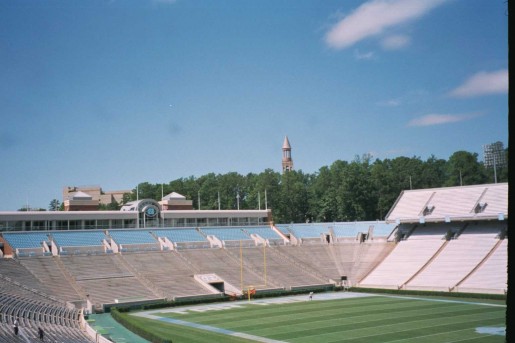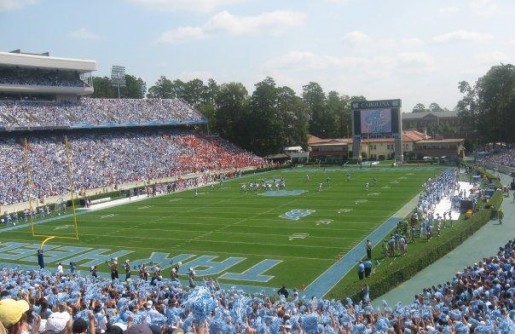Does the Deed to Kenan Memorial Stadium Require That the Stadium Never Reach the Height of the Trees That Surround it?
Here is the latest in a series of examinations into urban legends about football and whether they are true or false. Click here to view an archive of the football urban legends featured so far.
FOOTBALL URBAN LEGEND: The deed to Kenan Memorial Stadium required that the stadium never rise above the pine trees that surround the stadium.
Kenan Memorial Stadium is the home to the Tar Heels, the football team of the University of North Carolina (UNC). The stadium is nestled in a cluster of pine trees towards the middle of the Chapel Hill, North Carolina campus. It is one of the most beautiful college football stadiums that there is, particularly due to the way that it fits in so well with the landscape that surrounds the stadium. Built in the late 1920s, for decades the stadium never rose above the pine trees that surrounded it. This has led to an interesting “fact” about the stadium, that the man who funded the building of the stadium, William Rand Kenan, Junior, specifically required (either in the deed to the stadium or in a contract with the University) that the stadium never rise above the surrounding pine trees.

This does not appear to be true.
William Kenan Jr.’s connection to UNC went all the way back to its founding in the late 18th Century, as his grandfather was one of the school’s original trustees. He graduated from UNC in 1894 with a degree in chemistry and a minor in electrical engineering. While in school, he worked for a Professor F. P. Venable on a project for Thomas Wilson to find cheaper ways of producing aluminum. As is always the case, there is a dispute over who did what, but whether Kenan and Venable helped confirm a discovery that Wilson had already made (Wilson received a patent on the process) or (more likely) that they made the discovery themselves (and Wilson just took all of the credit), the end result was an economical process to make Calcium Carbide, which is used to produce the chemical Acetylene, which is itself used in Acetylene Lighting.
After graduating, Kenan first went to work for General Electric in Schenectady, New York, but his expertise in chemistry soon led him to work with Wilson at the Carbide Manufacturing Company (also in New York) on the development of carbide and acetylene. He worked in that field for many years (helping to build carbide plants all over the world), while also diversifying his holdings in New York (forming a number of companies in Lockport, New York, which is where he settled down with his family). Eventually, even though he was already quite successful on his own, he inherited control of an even larger fortune when his brother-in-law, the multi-millionaire Henry M. Flagler, passed away and Kenan’s sister gave Kenan control of her husband’s financial empire. Kenan used part of his fortune to purchase a 400-plus acre dairy farm in New York where he used his scientific expertise to become a pioneer in the field of dairy operations/farming.
That’s where Kenan stood in 1926 when he learned of the University’s plans for a new stadium. In the early 1920s, the Tar Heels played at Emerson Field, but it was soon becoming extremely evident that a 2,400 person capacity stadium was not going to cut it. The University began to reach out to alumni to see if they could raise the money to build a new stadium (they even had already received a sizable amount of donations). Kenan heard about the plans and decided to step in. He donated $330,000 in 1926 to build a new stadium and field house for the Tar Heels. Construction began in 1926 and the stadium was ready for the 1927 season. It expanded seating ten-fold, to 24,000 seats (plus with additional temporary seating, the stadium could fit up to 40,000 people). Kenan wanted to name the stadium in honor his parents, and on Thanksgiving Day in 1927, it was officially named Kenan Memorial Stadium.
Kenan was a great fan of nature, and he especially enjoyed the beauty of the surrounding pine trees. As the years went by, the pine trees always stood above the stadium. This eventually led to stories that Kenan specifically required that the stadium never rise above the pine trees. One version of the story is that it was part of the stadium’s deed. It is true that Kenan enjoyed the way that the stadium did not dwarf the woods around it, and since Kenan was still a very important donor (in 1963, he donated $1 million to UNC to double the seating in Kenan Stadium to 48,000), it just made good fiscal sense to not do anything that would possibly irritate Kenan.
By the time Kenan died in 1965, his younger cousin, Frank Kenan, had already taken over almost all of the controls of the Fagler-Kenan financial empire (Kenan Jr. had no children of his own) and was a prominent financial supporter of UNC, as well (Kenan attended UNC in the 1930s – he even played football for the Tar Heels!). By the late 1980s, the seating had been re-jiggered to fit another 2,000 seats in the stadium, but the school was looking for more, and one of the places they thought that they could find it was in the press box, which was on the ground. They wanted to knock the press boxes down and put in another 2,000 seats and put the press box at the top of the stadium. The only problem with that would be that they would have to be able to build above the pine trees. UNC athletic director John Swofford met with Frank Kenan to discuss whether there actually was any sort of stipulation saying that they could not build above the pine trees (as Swofford could find none). Kenan assured him that there was not, and thus, the press boxes at Kenan Stadium were built above the pine trees (well, at least they were in 1988, trees do grow, you know).
You can see here that the press boxes are above the trees…
Frank Kenan’s son, Tom, discussed the matter in a great article by Lee Pace for his Extra Points column about Tar Heel history:
Mister Kenan did want to preserve as many of the trees as possible. But the story that he said the stadium should never be higher than the trees was just mythology, but it’s not a bad idea if you ask me. He did love the trees and loved the landscaping around it. He thought that was the real beauty of the stadium, because there were very few stadiums in the country that had any setting like this one. That’s why it became known as one of the most beautiful stadiums. Most of them were downtown or they just dug a huge bowl in the ground and built the seats around the hole.
Various developments have seen the seating capacity grow to its current level of roughly 63,000, but future developments will see it grow even further (depending on budgetary concerns).
The legend is…
STATUS: False
Thanks again to Lee Pace for the great article about Kenan Memorial Stadium.
Feel free (heck, I implore you!) to write in with your suggestions for future urban legends columns! My e-mail address is bcronin@legendsrevealed.com






